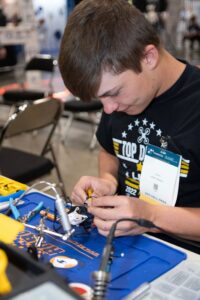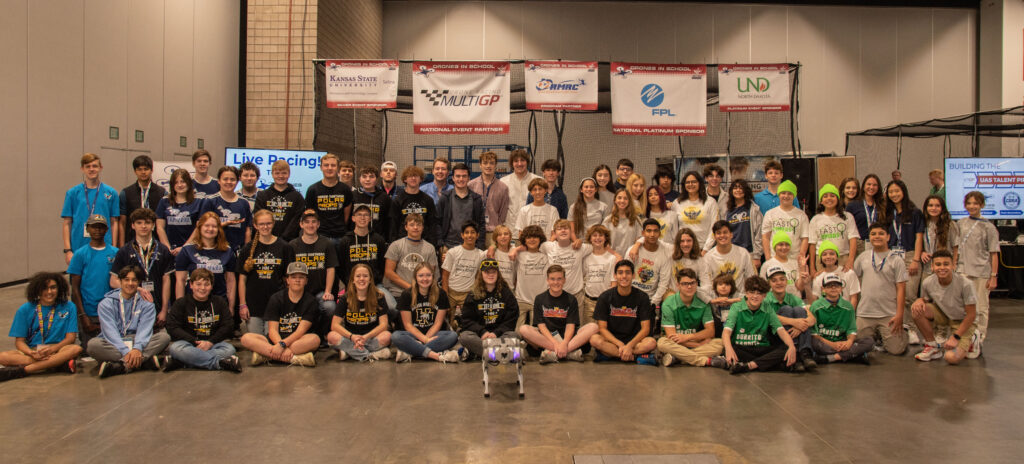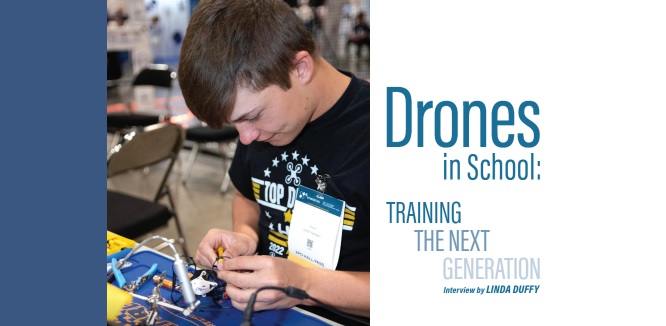Training the Next Generation
STEM education is preparing the next generation of workers for exciting careers in technology-related fields. Jobs that didn’t exist 20 years ago offer new opportunities for young people who have grown up in a connected, computer-savvy world. Whether racing drones, playing video games, or programming new apps, their life experiences and skills form the foundation for future contributions to businesses and the community.

The Drones in School program uses hands-on project-based learning to support STEM education.
EduEverything is a non-profit organization dedicated to hands-on STEM learning. The original group of educators in Marion, Ohio, participated in the Society of Mechanical Engineering (SME) Robotics Challenge since 1999 and took over organizing the competition in 2004. Executive director Tad Douce strongly believes it is important to expose students to STEM technology at a young age, so they understand the wide range of possibilities.
What is the mission of the Drones in School program and how does it support the broader goal of expanding STEM education?
Our mission is to make sure our students experience hands-on learning and know how to make real things—not just virtual. Teams go through an entire entrepreneurship process to build a drone racing team, as if they were starting a company. Team members are responsible for creating a logo, naming and branding, marketing visuals, and the mechanics of the drone itself.
They work with the equipment and trouble shoot problems. They learn how to interact with the local business community while lining up sponsors to help fund travel. Our program provides curricular depth that extends beyond STEM and teaches real business skills. As a founding member of the MultiGP STEM Alliance, we are working with other programs to build the unmanned aerial systems (UAS) talent pipeline.
What motivated EduEverything to start the Drones in School program?
In 2017 one of our robotics teams designed a drone for the robotics competition, and it created a lot of buzz and interest. We realized offering a drone program would be very attractive to students, so after some research we introduced drone racing. The investment is quite small compared to other STEM programs, making it accessible to all schools. It’s just $75 to register a team and we offer a reasonably priced kit, or they can use any kind of hobby-grade drone that meets our minimum requirements.
Drones are part of a growing geospatial industry that offers endless opportunities. They are being used for new applications all the time, such as mapping, search and rescue, and inspections. People are starting businesses, and they need workers with the skills we’re teaching. We feel it’s important to have a large funnel of students coming from STEM because companies need skilled workers. It is beneficial for the country and the globe to develop an innovative mindset.
Do you have a background in the geospatial industry?
After teaching pre-engineering for 15 years, I transitioned into educational consulting, specializing in teaching with technology, using STEM in the classroom, and developing STEM curriculum. Currently I am director of Educational Technology and Communication at River Valley Local Schools in Caledonia, Ohio, in addition to my work with EduEverything.

Teams were judged on their portfolio/display, including branding, design and engineering.
Who is your target audience?
Drones in School has two divisions, one for grades six to eight and one for grades nine to 12, and teams range from two to six members. The program appeals to a range of kids with interests in art, engineering, leadership, technology, and flying.
Teams with a lot of diversity are the most successful because students work on the tasks that interest them the most, with the project manager organizing their efforts. The program is also attractive to science teachers looking for hands-on projects.
How many schools around the country currently have teams?
We’re expecting 150 to 200 teams this season, spread across the country. We have five in Hawaii, 16 in Kansas, 20 in Ohio and over 100 in Florida. Florida Power and Light Company (FPL) is a big sponsor for the Florida schools. FPL is very progressive in the use of geospatial technology, and they are looking for innovative workers to fill the pipeline. Our program emphasizes innovation and problem solving, so it’s a good fit.
What is in the Team Startup Package?
The Startup Package saves the team time by providing the necessary equipment and instruction to get started. It includes two Emax TinyHawk III drones, first-person-view (FPV) goggles, two controllers, batteries, and a beacon for capture the flag. We offer a six-hour online workshop for advisors where they gain a basic understanding of the program and build their own racing drone.

The highest ranked teams competed in the National Race at AUVSI XPONENTIAL 2023 in Denver.
What are the main subjects covered in the curriculum?
The free curriculum available to teachers and advisors through TeachSTEM.org includes a broad range of subjects, including the history of flight, electrical circuitry and antennas, flying and battery safety, basics of drone flight, tuning and troubleshooting with the betaflight configurator, flying etiquette, best practices, and racing rules and techniques. We also offer online and live professional development workshops and instruction.
What are the job roles on the team?
In project-based learning, the students “own” the process. They are responsible for all aspects of creating a drone racing team, from designing a drone to creating a marketing campaign with animation, to 3D printing a display and finding corporate sponsors.
Each team consists of a project manager, graphic designer, manufacturing engineer, design engineer, marketing coordinator, and drone technician. We use a fantastic curriculum provided for free by the Project Management Institute Education Foundation for middle and high school students. By teaching students how to manage their own projects, we are helping them develop life-long job skills.
What is the race format? How many races are held each year?

Students raced their drones around an indoor course while wearing first-person-view (FPV) goggles.
There are three race formats: simulator, virtual and live. A simulated track is offered through the VelociDrone platform for a small license fee. Team members race and post their best times in four simulator events during the season.
We have four virtual races per year set up at each team’s location. Racers use a Universal Time Trial course and record their times on the designated track and submit verification online to enter the national leaderboard.
Teams within a region are invited to participate in live races hosted by one of the local teams. Live events feature all Drones in School judged categories: Head-to-Head Racing, Capture the Flag Racing, Portfolio/Display Judging, Design and Engineering Judging, and Marketing Video Judging.
The top 12 high school teams and 12 middle school teams are eligible for the national race, which has been hosted at AUVSI XPONENTIAL in Denver the past two years. The conference offered a wonderful opportunity for our students to see cutting edge robotics and uncrewed system technology in person.
How does exposure to technology at a young age influence future career choices?
I think it’s critical for the future that we have workers who are comfortable exploring new technology and being innovative to solve real-world problems. By exposing kids to STEM careers in middle and high school, they are made aware of their options and can start identifying their own areas of strength and interest.
Skills taught in Drones in School are transferable–how to troubleshoot, how to manage a project, how to operate a drone safely, and how to market your business. It’s also a great opportunity for businesses to encourage STEM education by being a team sponsor.

